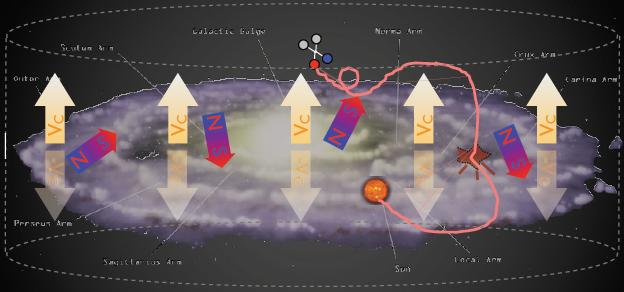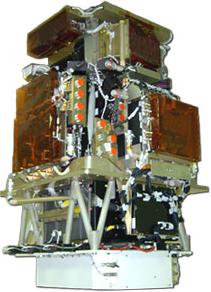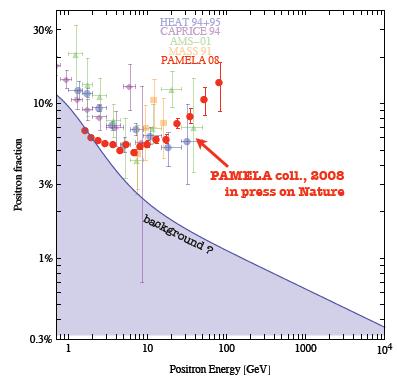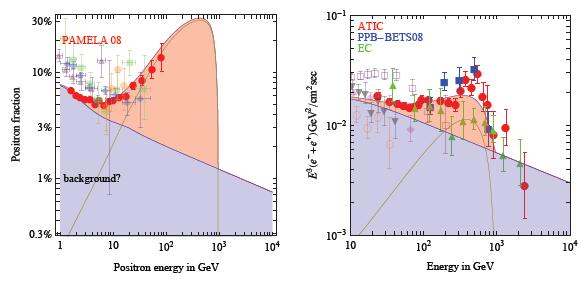 I participated with pleasure last month to a four-day conference devoted to neutrino telescopes, NEUTEL 2009, in Venice. Venice is my home town, and walking in the morning to the conference venue in Palazzo Franchetti (see left), a big and beautiful palace on the Canal Grande, was a pleasant change from my usual commute by train with Padova. In this short report I wish to offer a summary of an enlightening talk I heard there: the one presented by Marco Cirelli, a CNRS researcher in theoretical physics at CEA/Saclay, near Paris.
I participated with pleasure last month to a four-day conference devoted to neutrino telescopes, NEUTEL 2009, in Venice. Venice is my home town, and walking in the morning to the conference venue in Palazzo Franchetti (see left), a big and beautiful palace on the Canal Grande, was a pleasant change from my usual commute by train with Padova. In this short report I wish to offer a summary of an enlightening talk I heard there: the one presented by Marco Cirelli, a CNRS researcher in theoretical physics at CEA/Saclay, near Paris. The topic of the talk is all the rage these days: cosmology has withstood an accelerated expansion in the last twenty years, due to new technologies and space missions which have probed our Universe in a way incommensurably more precise than earlier means. The establishment of dark matter -the mysterious, non-luminous mass that makes up for almost one quarter of the total mass-energy budget of the cosmos- is one of the main ingredients of that evolution.
There are at least two reasons why dark matter is so popular these days. First of all, the inter-disciplinary nature of the means for its study, which range from space missions detecting the cosmic microwave background or indirect radiation signatures of dark matter annihilation, to high-energy particle colliders seeking new exotic particles, to super-sensitive underground devices seeking the elusive recoil signal of nuclei bouncing off slow massive bodies flowing by due to the Earth motion in our galaxy. And second, despite the large amount of experimental confirmations received in the last few years, the existence and the nature of dark matter is a source of unending controversy.
During the past year a few experiments have shown results which could be interpreted as a signal of direct dark matter detection. Among those, the time variation of a signal seen by the DAMA-LIBRA collaboration, the positron signal in cosmic rays seen by the PAMELA satellite, and the cosmic-ray results of the ATIC experiment. Marco Cirelli's talk devoted mainly to the latter two results; for a discussion of the DAMA-LIBRA anomaly see for instance this account by a fellow blogger, Resonaances.
The writeup of Cirelli's presentation which I offer below is taken directly from the notes I took in real time during the talk, and is probably not a very well-organized text, nor a very clear one. I apologize in advance for the inconvenience: for me, connecting the dots between my scribblings is never an easy task, especially after they have rested for some time unattended on my desktop. If you need more detail or a more coherent picture, I suggest you to check directly Marco's slides at the conference site.
The talk
Marco decided to address in a model-independent way the issue of whether today's experiments are seeing a dark matter (DM) signal. The problem is then to understand what data can really provide us with information about DM without tying it to any specific models for its nature. The questions that are begging to be asked are two: one, Are we indeed seeing dark matter in cosmic rays ?, and two, Why is there a new theory of DM on the ArXiv every other day ?
Cosmic rays may provide an indirect detection of DM if they are identified as the final products of the annihilation between two DM particles occurred in the galactic halo. The annihilation produces particle-antiparticle pairs of standard model (SM) fermions and bosons: these are the quarks and leptons that matter is made of, and the electroweak force carriers that make stars burn. Many searches for such signals focus on the detection of antiparticles in the cosmic-ray flux, because backgrounds for these are smaller. Thus, antiprotons are more valuable than protons, and positrons are more valuable than electrons.
(If you need a crash course on the cryptic names of all those fancy elementary particles, here is one: Fermions include quarks -which are the constituents of protons and neutrons, i.e. nuclear matter- and leptons -the electron and its neutrino, and two pairs of heavier copies of the former. Bosons are the messengers of the forces experienced by fermions; they include the photon, the W and Z bosons, and the gluons. Photons carry electromagnetic forces, W and Z carry the weak forces, and the 8-strong family of gluons keeps quarks bound together.)
Daughter particles from DM decay may get entangled in galactic magnetic field, be blown away from the wind of nearby stars, or suffer spallation when they cross the galactic disk; these effects remove them from the original flux. They thus typically get to us after suffering modifications in direction and energy spectrum; in particular, the latter becomes a convolution of several different terms.

The equation that encodes all the mentioned effects is solved in a box that encapsulates our galaxy. This equation tells us how to propagate the flux from its production point to the detector; it contains many free parameters, and it is further affected by uncertainties in the propagation model. Nothing is known from first principles about these effects; rather, inputs are inferred from previous data. Making a global fit of the data from cosmic ray experiments means marginalizing over all possible choices of these propagation parameters.
It is important to understand what sets the overall expected flux at the Earth. The flux is proportional to the square of n, the particle density (the square is due to our need of two particles to imagine their annihilation), and to the cross section for their annihilation reaction. Density n is dictated by Astrophysics and Cosmology, while the cross section depends on the particle physics model one is willing to consider. The reference cross section one should expect for two DM particles is of the order of 3x10-26 cm^3 per second: a particle with such annihilation rate would have gradually disappeared from the Universe at a such a rate as to exactly give the relic aboundance we see in the Universe today.
(Maybe a quick-and-dirty explanation of the above concept is in order here. We work under the assumption that a gas of these particles was in thermal equilibrium in the early Universe: their annihilation rate equalled their production rate, until expansion offset that balance, and annihilation started to dominate. Assuming a mass in the range of a few hundred GeV and infinite lifetime, a suitable annihilation rate may make today's extrapolated DM abundance match the one inferred by cosmological observations.)
A problem is that the signals observed by PAMELA and ATIC would require much larger cross sections to be attributable to DM annihilation. This brings up the question: how is DM distributed in the galaxy ? We do not really know, but we have simulations with which we try to infer the density n. Many N-body simulations have been done, and profiles of n as a function of the radius R from the galaxy center have been computed. There are different shapes, from so-called "isothermal shapes" to others (Moore computation) predicting a higher value of n in the center. These are also large uncertainties in such computations, and one must marginalize over those.
On top of the smooth profile of the n(R) function, one may have clumps and little overdensities of DM in the galactic halo, which have an important effect in the annihilation rate. There are clumps where DM is denser, and since the annihilation rate goes with the square of density, one may get an enhancement of rates which can amount to large factors. Typical cases go up to enhancements of a factor 20, but very exotic models can get up to factors of 10,000 enhancements, but these are extreme cases.
Computing the theory predictions can and should be done in a model-independent way: you take two DM particles, and suppose they annihilate. One does not in principle know how, so one just assumes they do it and produce pairs of primary particles, like W-boson pairs, or top-quark pairs, etcetera. These then in turn decay into stable bodies, and what one gets in the end is a flux of these final-state particles. The spectra for DM particles with a mass of 1 TeV have a high-energy endpoint at half that value, i.e. 500 GeV. The spectra one gets, however, of course depend on the assumed decays and their relative rates: for instance, in order to be produced at a sizable rate, antiprotons require the decay chain to proceed through a hadronization process -i.e., DM annihilation producing quarks, with quarks creating jets of hadrons.
The idea then is to provide as inputs not just the DM particle mass, but also the primary channels which begin the decay chain. All possible values of these can be scanned, to see what fits the data best.
Fitting the PAMELA and ATIC data
 The data in question are in this case those coming from the PAMELA satellite. PAMELA (right), which stands for "Payload for Antimatter-Matter Exploration", is a magnetic spectrometer made with a permanent magnet containing six double-sided silicon microstrip detector layers, complemented by a silicon imaging calorimeter, with a depth of 16 radiation lengths which is optimized for electromagnetic showers. The spectrometer measures the charge sign, rigidity (the momentum of the particle in units of its charge), and energy loss of charged particles, while the calorimeter discriminates hadronic and electromagnetic components at the level of 10^-5 up to 300-400 GeV.
The data in question are in this case those coming from the PAMELA satellite. PAMELA (right), which stands for "Payload for Antimatter-Matter Exploration", is a magnetic spectrometer made with a permanent magnet containing six double-sided silicon microstrip detector layers, complemented by a silicon imaging calorimeter, with a depth of 16 radiation lengths which is optimized for electromagnetic showers. The spectrometer measures the charge sign, rigidity (the momentum of the particle in units of its charge), and energy loss of charged particles, while the calorimeter discriminates hadronic and electromagnetic components at the level of 10^-5 up to 300-400 GeV.The satellite can therefore detect both positrons and antiprotons; the observed flux detected is shown in the graph below in the form of fraction of positrons over the total flux of electrons and positrons, as a function of energy. It can be observed that the data points lie way above the expected background, so in order to fit them one needs to add in a powerful source, as well as a mechanism providing a steep rise in the rate as the energy of the cosmic ray increases. The antiproton rate found by PAMELA is instead seen to fall with energy along with the predicted background, which is computed using our best understanding of known astrophysical processes. Of course, the background model has some uncertainty, which reduces the significance of any signal.

In the end, one can ask the question: which of the possible DM spectra can fit the PAMELA data ? Marco made some examples first, to show the applicability of his analysis method.
For a DM particle with mass of 150 GeV, this could be thought to typically annihilate into a W+W- boson pair. Such mass and decay would seem to fit the flux of positrons well. However, the antiprotons would not fit well in that scenario: PAMELA should then see many more antiprotons than what are observed, from the decay of W bosons to quark-antiquark pairs, and the subsequent hadronization processes. A DM candidate of that kind can therefore be ruled out with confidence.
Another example is a particle with 10 TeV of mass, which annihilates again into W boson pairs. This would fit the observed antiproton spectrum, because the resulting excess of antiprotons would move to higher energies, where there is no data to rule it out. Therefore, the above has to be considered a possibility: however, in order to make it work, one has to assume a cross section of 6x10^22 cm^3/sec, which is too high by orders of magnitude -calling for improbable "boost factors".
After the examples discussed above, it is time to see how the machinery works in a model-independent way: one then studies the chisquared of the fit to the energy distribution of the positron fraction which is seen by PAMELA. Adding to the fit the antiproton data, which do not have an excess, pure leptonic channels for the DM decay are left, and the possibility of decays involving quarks are confined to the high-mass region of dark matter particles. So one finds that a DM hypothesis is fitting the PAMELA data in two cases: if DM particles only annihilate into leptons -and in that case they can have any mass-, or if they have a mass of 10 TeV or larger, in which case they can annihilate in any way they like. In all cases, to fit the large excess of positrons one needs a boost factor: a big cross section. The reference thermal cross section is in units of 10^-26, so one needs an enhancement by four or five orders of magnitude.
After having examined PAMELA, one must consider the other datasets of cosmic rays, coming in particular from balloon experiments: ATIC and PPB-BETS. These are not limited to a few hundred GeV and go to higher energy, but the experiments are not equipped with a magnet, and cannot thus discriminate the cosmic ray charge. They content themselves with measuring the sum of electron and positron fluxes.
The sum of electrons plus positrons in the data shows a peak centered at around 500 or 600 GeV (see below, graph on the right). Now, suppose that there really is a peak there -as opposed to some systematical artifact: what would that then imply for the properties of dark matter ? It turns out that a DM particle with a mass of 1 TeV annihilating preferentially into electron-positron pairs would fit well all three sets of data. The figure below shows how such a hypothesis would provide the necessary complement (red areas) to known backgrounds from astrophysical sources (in purple) to explain both the data points of PAMELA (left) on the fraction of positrons, and the ATIC/PPB-BETS data on the total flux of electrons and positrons (right).

From this analysis it results that one has to consider the possibility that we after all have we identified DM for first time. Marco Cirelli, however, insisted that we need to be cautious. He is not alone, but other theorists have instead enthusiastically started to ride the PAMELA hump: there are literally dozens of papers which have appeared on preprint servers since last fall.
The ingredients of many of the models put forth to explain the observed cosmic ray fluxes are always the same: hadrophobic particle decays, a high mass of the primary DM particle, etcetera. In model independent analyses such as the one performed by Cirelli et al., the DM mass which fits best is centered at 1 TeV. Here, there are two important remarks which need to be made. The first one is that what PAMELA and ATIC are observing might just be due to a couple of pulsars, or to some other non-exotic astrophysical source. In fact, one idea studied in detail by Stefano Profumo is that the positrons are coming from diffuse mature and nearby young pulsars. According to Cirelli, however, such scenarios may easily explain the PAMELA data, but it is not so clear that they fit well the ATIC signal.
Checks of the results with other datasets
The second important note is that besides charged cosmic ray results, if one is willing to consider the DM hypothesis one should be careful about associated gamma rays and radio constraints from data collected from the galactic center and dwarf galaxies. In fact, gamma rays from DM annihilations in the galactic center are a wholly independent story from what has been discussed above. This is the emission of gamma rays from the same chain of annihilation and decay of DM particles considered this far.
To study the gamma-ray flux and understand whether there may be a component due to dark matter decay products, one must look at the galactic center with photon-sensitive devices and integrate the flux in a cone selected by the telescope one is using: the signal from DM annihilations would be an enhancement of sub-TeV gamma rays. Another idea is to look at dwarf galaxies around of our own: this is a good idea because backgrounds coming from sources away from the center of our galaxy are much smaller.
Moreover, one can also look for radio waves emitted by synchrotron radiation produced by electrons and positrons in the galactic center. In order to compute the expected signal one must assume some shape for the magnetic field in the galactic center. Then one may try to compare such a prediction with data.
The HESS telescope found a number of gamma sources by looking at a very small circle centered on the galactic center, and around it. The experiment found that data points of the gamma-ray spectrum follow a steep power law as a function of energy. Since dark matter annihilation will never give a power law, what one has to require to one's favourite DM model is that the flux of gamma rays emerging from the annihilation never exceeds those data points, in order to not be ruled out.
In radio waves the story is similar; the data are very constraining. Taken together with the observed gamma ray fluxes, they in fact can exclude the favoured solution of 1 TeV mass, lepton-annihilating dark matter particles suggested by positron and electron excesses. The important thing here, however, is that this result depends on a very arbitrary choice for the profile density of dark matter in the galaxy. If one changes the galactic profile, some of the regions of mass and cross section of DM candidates cannot be excluded any more. Marco Cirelli stressed this point: if the profile of DM is not so dense at small radii, then fewer gamma rays are produced in the center of the galaxy, with the result that the constraints from the power-law of the HESS spectrum are sidestepped.
Conclusions of Marco Cirelli's talk
Concluding the talk Marco tried to provide his own answers to the questions posed at the beginning. Are we seeing dark matter in cosmic rays ? He is sceptical, claiming that the interpretation is unlikely because the characteristics that DM should have are too peculiar. Maybe what is being observed instead is just a trivial astrophysical signal, like the one coming from a pulsar.
As for the second question, Why are there so many DM theories in the ArXiv?, Marco explained that since it looks as if the observed PAMELA and ATIC signals point to a weird kind of DM, theorists are now trying to reinvent the field: the dark matter particle must be heavyish, annihilate mainly into leptons, have a huge cross section via boost factors or other particle physics-inspired forms of enhancements, and not produce too many gamma rays, otherwise it is excluded by other measurements. This is both a stimulating and confusing picture, and theorists evidently thrive in this confusion.
It is conforting to know that future data will be able to clarify the situation soon: the FERMI satellite (ex GLAST), ATIC-4, new PAMELA data, and AMS are all expected to produce significant advancements in our understanding of cosmic ray spectra.
Other recent papers by the speaker on this topic:
G.Bertone, M.Cirelli, A.Strumia, and M.Taoso, "Gamma-ray and radio tests of the e+e- excess from DM annihilations"
M.Cirelli and A.Strumia, "Minimal dark matter predictions and the PAMELA positron excess"





Comments